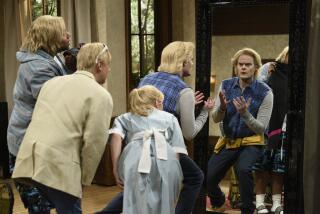Twisted Simpsons Spark Mania : Television: The popular show has developed a cult following in schools, at the mall--even at the San Onofre nuclear plant. But a school principal in Orange says the antihero Bart is a bad influence on pupils.
- Share via
The cartoon antihero peers out bug-eyed from the T-shirt rack. “I’m Bart Simpson. Who the Hell Are You?” On another shirt, Bart is labeled an underachiever “And proud of it, man.” In a family portrait, his father is squeezing his neck so hard his tongue hangs out.
They’re disturbed. They’re twisted. They’re “The Simpsons” and they’re red-hot in Orange County.
A Sunday night TV cartoon show about working-class, dysfunctional parents named Marge and Homer and their three children, “The Simpsons” has become a local phenomenon as well as a national one, sparking a cult following of sorts in schools, at the mall, at home--even at the San Onofre nuclear power plant.
In Orange County, stores are selling out of Simpson T-shirts, at least one elementary school has banned them and an entire fraternity house--devoted to the irreverent rebel Bart--holds regular Sunday night Simpson sessions around the TV.
“It’s surpassed the Batman phenomenon of last year,” said Linda Goetzman, manager of Pacific Eyes & T’s in Irvine, uncrating a new shipment of Simpsons T-shirts. Avis Swallow, a clerk at Costa Mesa’s JC Penney, said: “Ours went really fast.”
Gerry Johnson of Santa Ana said her husband bought several bootlegged Simpsons T-shirts for $5 from a Los Angeles vendor who had been shut down by police by the time Johnson went back for more.
Simpson family shirts are showing up at the Orange County Swap Meet as well as a heavy metal shop, displayed next to racks of leather clothes and chains.
The flip side of the heart-warming Cosbys, the Simpsons represent a sudden shift in the way society views parents, social historians said. Where parents used to be seen as caring, responsible and self-sacrificing, they are now confused, inept and surly.
The Simpsons mean well but teeter on the edge of chaos.
Homer works in a “family-oriented” nuclear power plant, tosses excess uranium from his car, encourages his young son to disobey his mother and counsels him with such platitudes as “a boy without mischief is like a bowling ball without a liquid center.”
Marge, a misguided new-age feminist, sports a blue cone-head hairdo and solves problems with equally unhelpful advice (“There, there”). When they go for family counseling, the therapist pays them to leave.
Bart, a fourth-grader, cheats on tests, drops cherry bombs down toilets and talks back to what used to be known as authority figures with barbs such as “Eat my shorts.”
In short, “Bart does what every kid wants to do,” said Lexie Weinberg, 11, of Huntington Beach. Most of her sixth-grade classmates at Mesa View Elementary School in Huntington Beach had the same favorite Bart line from the show: “Don’t have a cow, man.” Ted Norman, 12, offered a perfect imitation of Marge’s cracked voice saying, “Oh, Homer.”
Principal Jamie Brown at Cambridge Elementary School in Orange said he and the teachers agree that “the program is not a positive influence. It’s making a cartoon hero out of a boy we don’t wish to have modeled at school.”
A fifth-grader was told not to wear his “Who The Hell Are You?” shirt to school again because the language was “inappropriate.” Brown said, “He was very cooperative.” The “Underachiever” T-shirt is also inappropriate, he said.
Last week, he said, he checked Simpson shirts worn by about 30 children at school.
Although the 8:30 p.m. show was never intended for children (Marge nearly consummated an affair with her bowling instructor; Bart used a spy camera to capture Homer with a belly dancer at a bachelor party, then circulated the photo), the second strongest market is among 6-to-11-year-olds, said show researchers.
Since its debut in January, the show has ranked No. 1 among prime time viewers in the 18-to-34 age group, particularly in urban families with incomes above $60,000. One week in April, 59% of all teen-age viewers were tuned into the Simpsons.
Monday mornings, co-workers at the San Onofre nuclear plant trade jokes about the show, which frequently features Homer working at the plant, said Linda Kinkade, emergency planning specialist. But some scenes disturb her, she said, such as a recent episode in which Homer unknowingly brings in a grade-school spy who snaps pictures of top secret equipment and sends it to Albania.
“When you see things like this, it makes people think about things they don’t need to think about, and that wouldn’t ever happen,” she said.
Meanwhile, Simpsons publicist Antonia Coffman said she is swamped with requests by public schools, charities and environmental groups seeking to use the characters for their causes. A psychiatrist from the University of Wisconsin Medical School asked for a clip from the show in which the Simpsons, under the exasperated guidance of a therapist, nearly knock one another unconscious with electric shocks. “He said it would lighten up his lectures,” she said.
Bart is the star and hero every Sunday night when 20 members of the Delta Chi fraternity at Cal State Fullerton gather to watch “The Simpsons.” “We just scream when he’s in trouble,” said Jesse Mallinger, 21.
“We love the family,” he said. “Except when Marge was seeing another guy. We thought Homer should have given her the boot. But that would have been bummin’ for Bart.”
Their favorite phrase? “This place bites.”
The irreverence of “The Simpsons” mirrors “the skepticism that many young adults feel,” said Barbara Dafoe Whitehead, a social historian and analyst for the Chicago-based Public Policy Associates. “Many of them have lived through the divorce revolution.”
Along with “Roseanne” and “Married With Children,” the television show represents a darker portrait of family life that reflects their reality, she said.
“A generation ago, we had Ward and June Cleaver.
“The one thing about Ward and June’s world, everyone from Eisenhower on down thought that the most important thing they could do was take care of Wally and the Beaver.”
Now, she said, “we have virtually no confidence that parents can do anything right. They can’t even protect (their children) from danger. They’re more content to teach kids karate so they can defend themselves.”
Experts disagree on whether children are better off watching the realities of an insecure family life or the airbrushed illusion.
“Children love images of perfect families. Kids find it reassuring, like a glass of warm milk before going to bed,” Whitehead said.
But the high proportion of children whose families do not meet those standards can be left feeling cheated and more isolated, said Arthur M. Bodin, a Palo Alto based psychologist and past president of the Family Psychology Division of the American Psychological Assn.
“It probably feels good to have somebody else noticing and portraying the quirks that they saw (at home),” said Bodin.”I would even hazard a guess that the show could have an educational impact by being such an obvious parade of things not to do.”
Unlike the milk-and-cookie TV families, the Simpsons offer a comic relief to reality, he said. “It allows people to feel good by comparison.”
More to Read
Sign up for Essential California
The most important California stories and recommendations in your inbox every morning.
You may occasionally receive promotional content from the Los Angeles Times.













